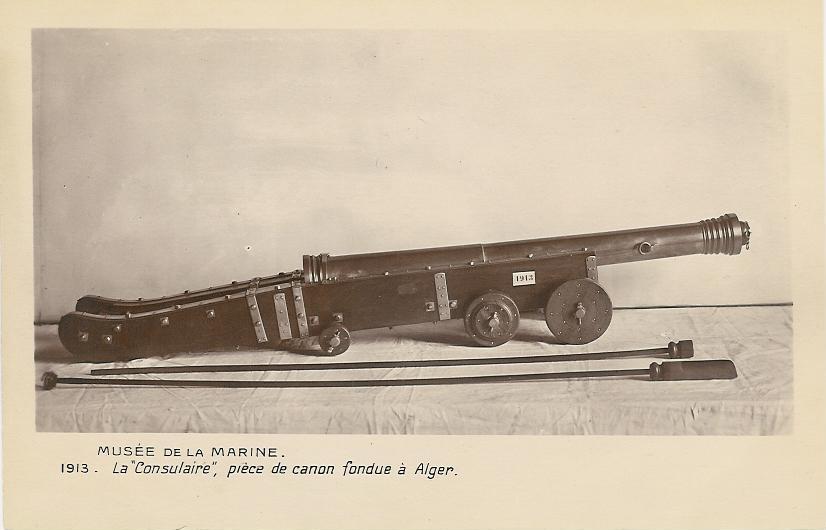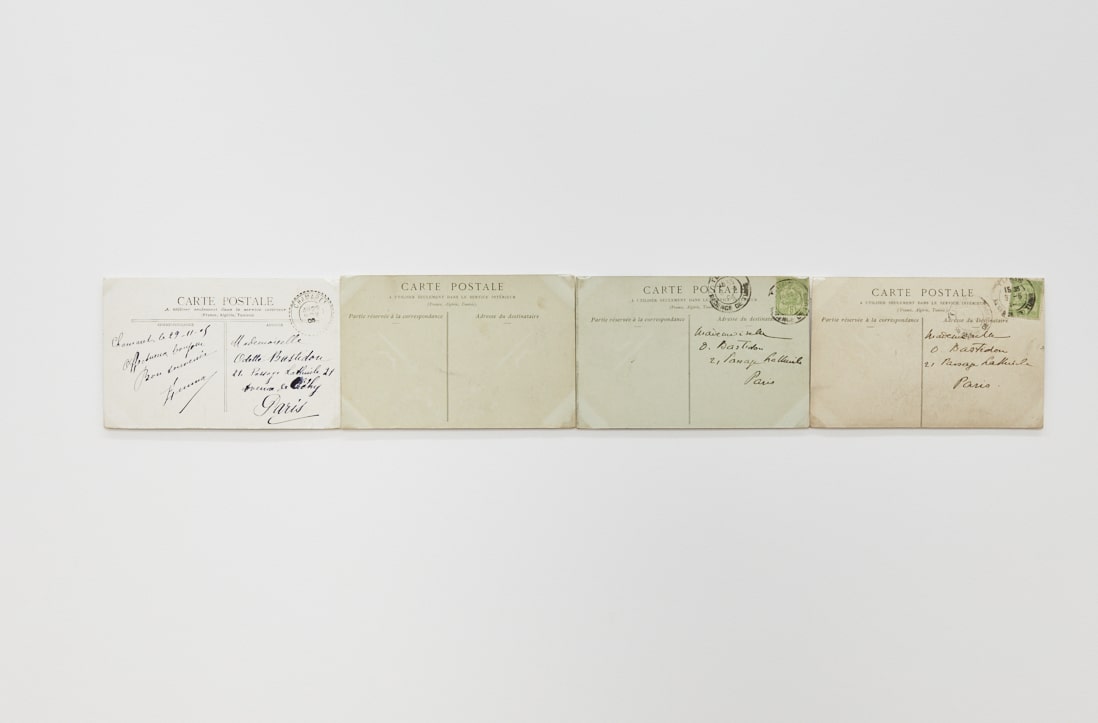KJ Abudu: In your press release, you write: “In 1827, Charles X founded the Musée National de la Marine. He would initiate the Invasion of Algiers three years later.” Usually we think about museums as storage houses for colonial spoils of war, but I wonder whether it’s actually the other way around: that the museum requires colonial violence as a precondition to establish itself as such. In other words, it needs objects expropriated from elsewhere to make sense of itself as an institution. I think it’s Hortense Spillers who posits that if there were no Black people in the United States—if the transatlantic slave trade had never occurred—the nation would have had to invent them. Can we transpose this metaphor onto the museum?
Sophie Kovel: You’re making a critical comparison between the museum and the nation-state, the nation-building project, or a national imaginary. And colonialism, imperialism, and slavery are entwined with the French and American nation-building projects, among others. The press release sought to make that claim; similarly, the first postcards in the sequence picture Versailles, where the Code Noir was signed into existence, marking the co-constitution of the Renaissance with colonialism and slavery.
KA: I think of the museum as an ideological state apparatus entwined with the installment of Western liberal democracy. It comes into being because the modern secular state needs to “educate” its citizens, as part and parcel of the production of a civic public sphere—like the library, the university, et cetera.
SK: The church.
KA: The church. The French revolution crystallizes an idea of liberal democracy, which leads me to the part of your press release about the racial occlusions of the liberal, democratic, nationalist imaginary to which France and America are forever aspiring. Many postcolonial states also aspire to this mythic promise of liberty, equality, and property. The question haunting this liberal formula, especially when viewed historically, is who/what constituted property? C.L.R. James delves into this in The Black Jacobins, as you cite too: “Long before 1789 the French bourgeoisie was the most powerful economic force in France, and the slave-trade and the colonies were the basis of its wealth and power. […] The fortunes created at Bordeaux, at Nantes, by the slave-trade, gave to the bourgeoisie that pride which needed liberty and contributed to emancipation.”1 Following on from James, one could say that the specter of raciality and coloniality sustains the idea of the museum as an institution, and we can extend this structuring contradiction to the broader project of liberalism.
SK: Raciality, coloniality, and genocidal acts at the foundation of conceptions of property rights likewise haunt the question of restitutional politics.
KA: Something that bothers me in the discourse on restitution is this framing of “the return of the object” as a salve to centuries of violence: this idea that returning the object somehow heals the colonial wound, or restores the object to its so-called original economy of value and meaning. This of course is not the view of scholars, such as Zoé Samudzi, who engage capaciously with the irreparable.2 In my view, real restitution and reparations, if followed through to their logical conclusions, would require the abolition of the very idea of France, of Europe, of the Global North. France cannot follow through with a program of restitution, because in doing so it would cease to exist—its very self-identity is premised on the historical subjugation and ongoing expropriation of its neo-colonies. To echo Denise Ferreira da Silva, the debt is unpayable. France can’t give back its colonial spoils and still be France, just as the museum cannot decolonize itself and remain a museum.
SK: Exactly. Thinking restitution destabilizes longtime understandings of national identity. Samia Henni writes about the role of euphemism in French colonial history and historiography: for instance, legislation instituted under Jacques Chirac dictating that, in official and educational settings, the Franco-Algerian war could only be called les évènements d’Algérie (“the events in Algeria”), les opérations de maintien de l’ordre (“operations for the enforcement of law and order”), or la question algérienne (“the Algerian question”). This legislation was only amended in 1999, over thirty years after the ceasefire. There is French legislation around cultural restitution, but few other forms. Objects such as arms aren’t juridically eligible for restitution. As you know, the central subject of A Long Duration of Losses is the Baba Merzoug—renamed by the French as La Consulaire—an Algerian military canon designed and erected to resemble the Bastille column, an icon of the French Revolution. So what can be thought of as a subject of restitution?
KA: Kader Attia might be useful again here. The way he thinks about repair is generative to the discourse of restitution. In the liberal media, there’s this idea that you were whole before, then there was a horrible event, and now you need to be made whole again. I think there’s a libidinal drive informing this desire to return to wholeness that’s bound up in a Western notion of what wholeness and repair even mean: the absence of injury, the disavowal of trauma. Which is just not universally valid. Whether he’s looking at mended indigenous African artifacts or even Japanese ceramics, Attia points to alternative, non-Western grammars of repair where the process of reuniting fragmented pieces does not erase the scar. Erasing the scar produces a kind of amnesia regarding the terror of the racial/colonial event and its ongoing reverberations. The performance of amnesia—what Charles Mills calls an “epistemology of ignorance,” which in many cases fuels whiteness—is a sort of knowing unknowingness. You know but pretend you don’t, or worse, you know and don’t want to look. The idea that we can restore ourselves to wholeness is a myth; we need to acknowledge the injury, sit with it, live with the ghosts, and use that as the catalyst for regeneration. We need to say, “You won’t be the same as before, and that’s okay.”
SK: On the topic of imposed amnesia created by laws that insist on the not-telling or euphemizing of colonial violence, the architect Mark Wigley writes, “Architecture is literally erected in the face of memory loss.” We might expand this: architecture is memory construction, and for monuments in particular, it’s the construction of patriotic memory, patriotic history. As Mabel Wilson has written, “to build is to have power.”
KA: You argue that the Baba Merzoug isn’t a monument until it’s appropriated and erected as one. Can you say more about the context there?
SK: In 1830, France invaded Algeria and seized the Baba Merzoug, an Ottoman-era cannon that protected the Bay of Algiers. It was brought as a spoil of war to the port of Brest, and erected three years later as a site of memory.
KA: So this object was used to defend Algeria, then became a monument to France’s imperial victory: its meaning shifts even though the object stays the same. I’m also thinking about how the postcards in your show were meant for “interior circulation only.” To me this relates to France’s nationalist disavowal of difference and its investment in universalism, which paradoxically depends on the phantom presence of its overseas departments and neocolonial strongholds in North and West Africa, the Caribbean, and Asia.
Sophie Kovel, Lieu de mémoire (à utiliser seulement dans le service intérieur), 2017–present. 67 French colonial postcards (circa 1904–10); hung at the height of the surrounding fence at La Consulaire, Brest. 14 x 9 cm. Courtesy of the artist and Petrine, Paris. Sophie Kovel, Lieu de mémoire (à utiliser seulement dans le service intérieur), 2017–present. 67 French colonial postcards (circa 1904–10); hung at the height of the surrounding fence at La Consulaire, Brest. 14 x 9 cm. Courtesy of the artist and Petrine, Paris.
SK: The postcards reveal the mail system as a colonial vector, considering these colonies “interior” to French empire and perpetuating through their imagery some of the ideological state apparatuses of liberal democracy: Versailles, romantic landscapes, churches, universities, banks, bourgeois leisure, the nuclear family, even the photography studio itself. You’re left with a promotional national imaginary on one side of the cards and the present tense of empire on the verso. The postcards encircle the space of the exhibition, hung at the height of the fence surrounding the Baba Merzoug in Brest. My idea was to reflect this apparatus protecting the monument, but ask what happens when the iron barrier is reimagined as the building of national and civic imagery. The engravings that juxtapose the Baba Merzoug and Bastille column side by side also rearticulate this. And the third component, the crowning object on the Baba Merzoug in Brest, is the Gallic cockerel, a symbol of France commonly seen on soccer jerseys and government websites. On the La Consulaire monument, it has a sphere or globe in its talon. My re-envisioning seeks to make the cockerel stumble, putting the sphere of empire out of reach.
KA: These formal decisions are a really clever way of instrumentalizing minimalist seriality, which has its own historical indexes. How does this project relate to your incisive meditations on American politics? I’d love to hear your thoughts on the analogous dynamics of nationalism and colonialism in that geopolitical context, and how you employ semiotics, psychoanalysis, and historical materialism as artistic and research methodologies.
SK: Methodologically speaking, what connects A Long Duration of Losses to recent projects about American ethnonationalism is a focus on a specific event, and how that event is told—or not told—by history. Nothing can be lost to history, but these events have been forced into a sort of collective amnesia. I’m interested in work that stages or recovers these events for testimony or witness in the present. They often consider a confounded relationship to the state apparatus, for example with recent work about the American whistleblower Reality Leigh Winner—an oscillation between building up an object or person as an icon of a national project and the deep disavowal of that person-object-icon by the state.
Courtesy of the artist.
KA: In a way I think you’re speaking about iconoclasm, which aims to unsettle the stability of these world-cohering icons. A reenergized discourse has emerged recently in the wake of many colonial monuments around the world being toppled. Some argue that although these acts produce a symbolic potency, they don’t translate into economic or material transformation. I think your work stages an open-ended question on the efficacy of iconoclasm as ideological critique.
SK: M. NourbeSe Philip writes beautifully about the tearing down of monuments as an extrajudicial possibility. What drives me is: how might cultural production enact a kind of extrajudicial possibility?
KA: It’s interesting how iconoclasm is so often praised as progressive, whereas I think its value is neutral. As we observed with the January 6 incident in the United States, iconoclasm can also tilt the other way. It’s not necessarily seeking justice, but it does catalyze possibilities. And monuments are these material embodiments of symbolic and libidinal economies. They’re not functional in a housing sense, but they’re supposed to direct the flow of ideological traffic in a given space. Iconoclasm is a way of redirecting that flow.
SK: Early on I was working with the idea of the “site of memory,” which has been defined as a site of struggle between memory and history. This struggle cannot exist without place and space—without site.
KA: For Pierre Nora, monuments are often materializations of history with a capital H. The state-mandated narrative. So iconoclasm, whether coming from a progressive or a reactionary perspective, is history’s overflow, its unprocessed fodder. Perhaps it’s the piercing of the membrane that makes History cohere.
SK: You’re right, Nora theorizes how monuments stand in for that excess, the loss of the environment of memory. To conclude, I want to return to the idea of museum storage as a site of the subconscious. When the Bastille was stormed in 1789 for its armory, it also held political prisoners who were released. In other words: the storming of the Bastille was not only a civic attack on the monument. And so we can further complicate the Bastille column as a site—maybe even an exemplar—of ideological struggle.
KA: This proves what we already intuit: this irreducible tension between liberty and liberation. The horizon of abolition will always unsettle the establishment of so-called free property, and universality, properly understood, will always be this unbounded excess that calls into question any complacency that we’ve arrived at a conclusive totality. It’ll always be this outside that’s like, “No, we’ve been excluded, actually.” This continuous iterative revision grounds the idea that the struggle is ongoing.
KJ Abudu and Sophie Kovel, October 2023
1 C.L.R. James, The Black Jacobins: Toussaint L’Ouverture and the San Domingo Revolution, Secker & Warburg Ltd., 1938.
2 Zoé Samudzi and Noor Asif, “Breath Back – An epistolary introduction to reparation and repair”, Parapraxis, https://www.parapraxismagazine.com/articles/breath-back © The Psychosocial Foundation, 2023.
On Cameron Rowland’s work, also read Zoé Samudzi, “Rethinking Reparations”, Art in America, 2023 : [PDF]
KJ Abudu is a critic and curator based between London, Lagos, and New York. Informed by anti/post/de-colonial theory, queer theory, African philosophy, and Black radical thought, his writings and exhibitions focus on critical art and intellectual practices from the Global South (particularly Africa and its diasporas) that respond to the world-historical conditions produced by colonial modernity. KJ Abudu is the editor of Living with Ghosts: A Reader, Pace Publishing, 2022. He will also be curating “Clocking Out: Time Beyond Management” at Artists Space, New York, May 2023, and “Traces of Ecstasy” at the fourth edition of the Lagos Biennial, 2024.
Sophie Kovel is an artist and writer. Her work examines the economic, social, aesthetic, and ideological operations of racial nationalism. Kovel’s criticism has been published in Artforum, BOMB, Frieze, Spike, and elsewhere, and recent exhibitions include Kunsthal Charlottenborg, Denmark; the Jewish Museum, New York; Jenkins Johnson, New York; University of California; Los Angeles; and Petrine, Paris.


